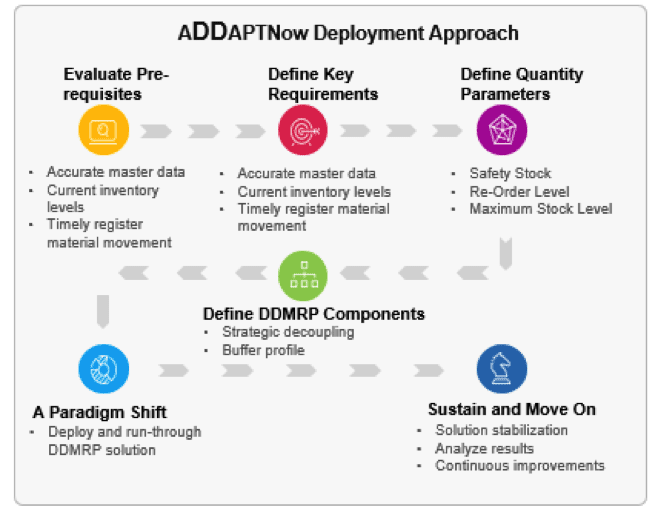Getting to Know DDMRP
Business Transformation and Technology Adoption
In the recent past, businesses have seen rapid changes in customer behavior and technology use as well as a rise in social media’s ability to influence buying decisions. Because customers are more demanding, organizations are now forced to produce more personalized products (made to order), rather than rely on traditional manufacturing models, where different variants are produced and then sold into the market (made to stock). It is increasingly more difficult to predict demand patterns, and trends on social media may alter prior forecasts. To assure continued growth and business sustainability, use of more modern technology like Big Data, IoT, Machine Learning and Artificial Intelligence is imperative.
MRP Evolution and the Introduction of DDMRP
As the business transforms, the ways and means of traditional planning and execution change as well. The evolution of planning tools – from inventory control packages in the early 1960s to MRP (Material Requirements Planning), then to comprehensive ERP solutions – reveals technology changes to cater to evolving business needs. The Demand Driven Institute has paved the way to the new age of demand-driven technology for material planning. Demand Driven MRP (DDMRP) uses demand-driven strategies and practices to help businesses become more agile and responsive to varying market demands.
How DDMRP Benefits Businesses
In addition to generating supply orders, like traditional MRP, DDMRP also carries out dynamic adjustments to redefine level of protection across the supply chain. This level (in the form of inventory buffers) flexes up and down based on definite parameters to reflect market changes. Dynamic buffers are placed at different levels specifically at bottlenecks and excess inventory positions (strategic decoupling). This results in dampening the bullwhip effect that creates inventory imbalance for businesses with large demand variations. Decoupling helps create independent and shorter horizons across the supply chain. The net effect is lead time reduction and optimum inventory levels.
Key Terminology
DDMRP is conceptualized by several key terms, including:
- ADU (Average Daily Use) – an estimate of daily consumption rate
- DLT (Decoupled Lead Time) – intermediate lead time on the longest BOM path assuming all materials are available
- Variability Factor – helps define buffer level based on variability classification (XYZ)
- Lead Time Factor – helps define buffer level based on lead time classification (EFG)
- Buffer Levels – determination of buffer according to lead time, demand and variability
The Five Components
DDMRP is driven by five components:
- Strategic Inventory Positioning
- Buffer Profiles and Levels
- Dynamic Adjustments
- Demand Driven Planning
- Visible and Collaborative Execution
Buffer Levels
DDMRP emphasizes dynamic buffer adjustment. It is defined with three buffer levels:
- Safety Stock
- Reorder Point
- Maximum Stock Level
These three levels are dynamic in nature, changing with variations in demand and lead time, past consumption, and BOM usage.
DDMRP Execution
SAP S/4HANA enables Fiori-based DDMRP configuration and execution. These Fiori apps include configuration (supporting) apps and business apps. The execution process involves the following steps:
- Buffer Profile Maintenance – lead time and variability factors are defined
- Product Classification – product is classified based on various factors, such as:
- XYZ Classification, based on demand variability
- EFG Classification, lead time variation
- ABC Classification, based on material valuation
- PQR Classification, based on BOM usage
- Buffer Positioning – determines the place at which buffers are to be positioned
- Buffer Calculation – system calculates dynamic buffer levels based on product classification above a given point of time
- Buffer Level Update – material master data is updated once proposed buffer calculation is adopted
- Replenishment Planning – the planning run creates supply orders as per updated material master records
- Replenishment Execution – helps expedite supply orders
How Bristlecone Can Help
By leveraging specialization in operational effectiveness, supply chain and analytics, Bristlecone has defined its unique deployment approach ‘ADDAPTNow’ to implement DDMRP assignments. This structured approach to project implementation involves three key phases:
- Discovery Phase – understand the current supply and demand situation
- Realization Phase – build solution
- Deployment Phase – swiftly change over to demand-driven technology
The diagram below illustrates the approach in greater detail.

Bristlecone’s ‘ADDAPTNow’ solution for SAP S/4HANA DDMRP implementation is beneficial across industry sectors, including CPG, Life Sciences, Chemicals and Discrete Manufacturing. The solution helps increase service levels, optimize inventory and reduce lead time. Industries with large variations in demand stand to gain maximum benefit from DDMRP technology.







